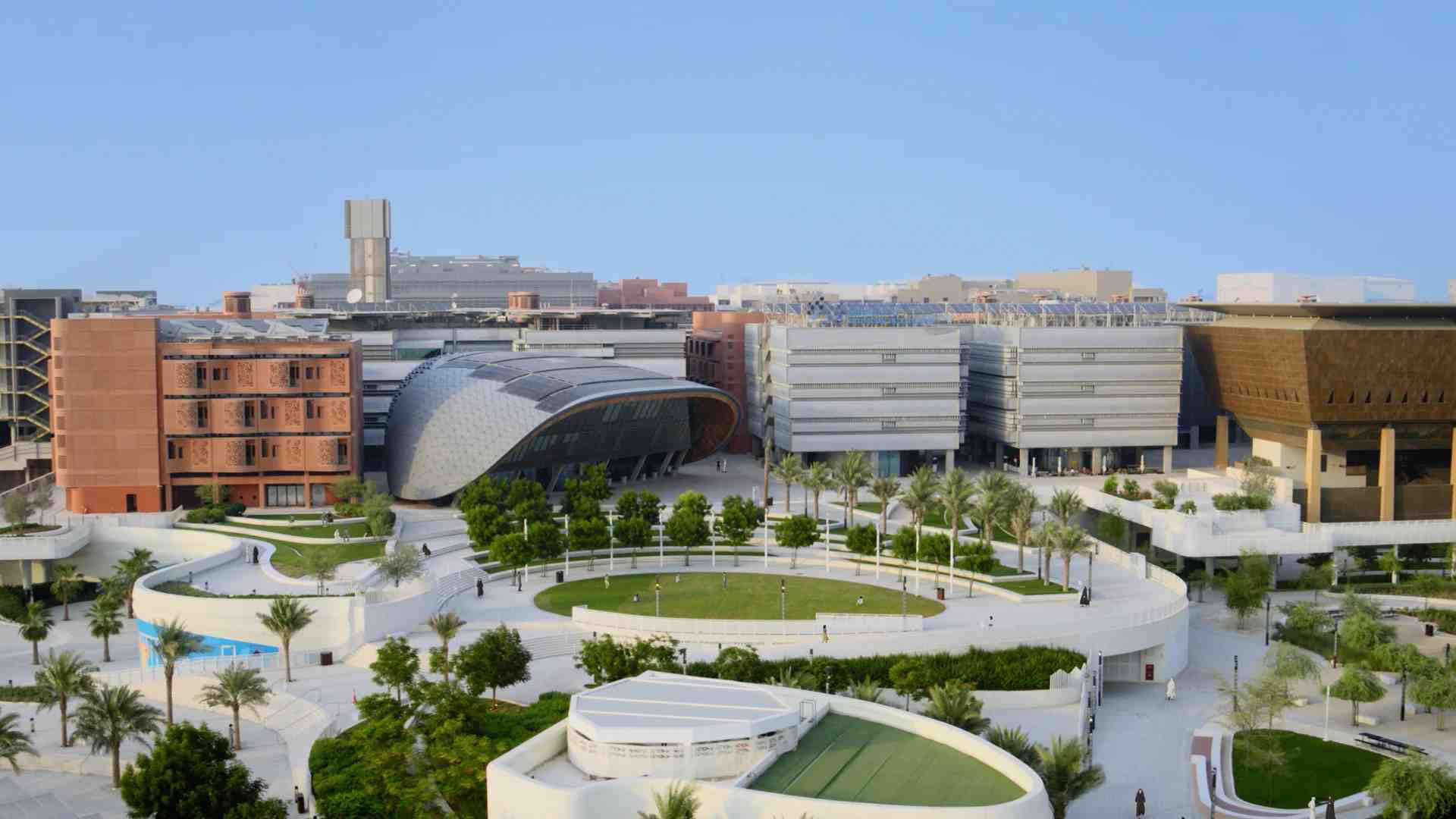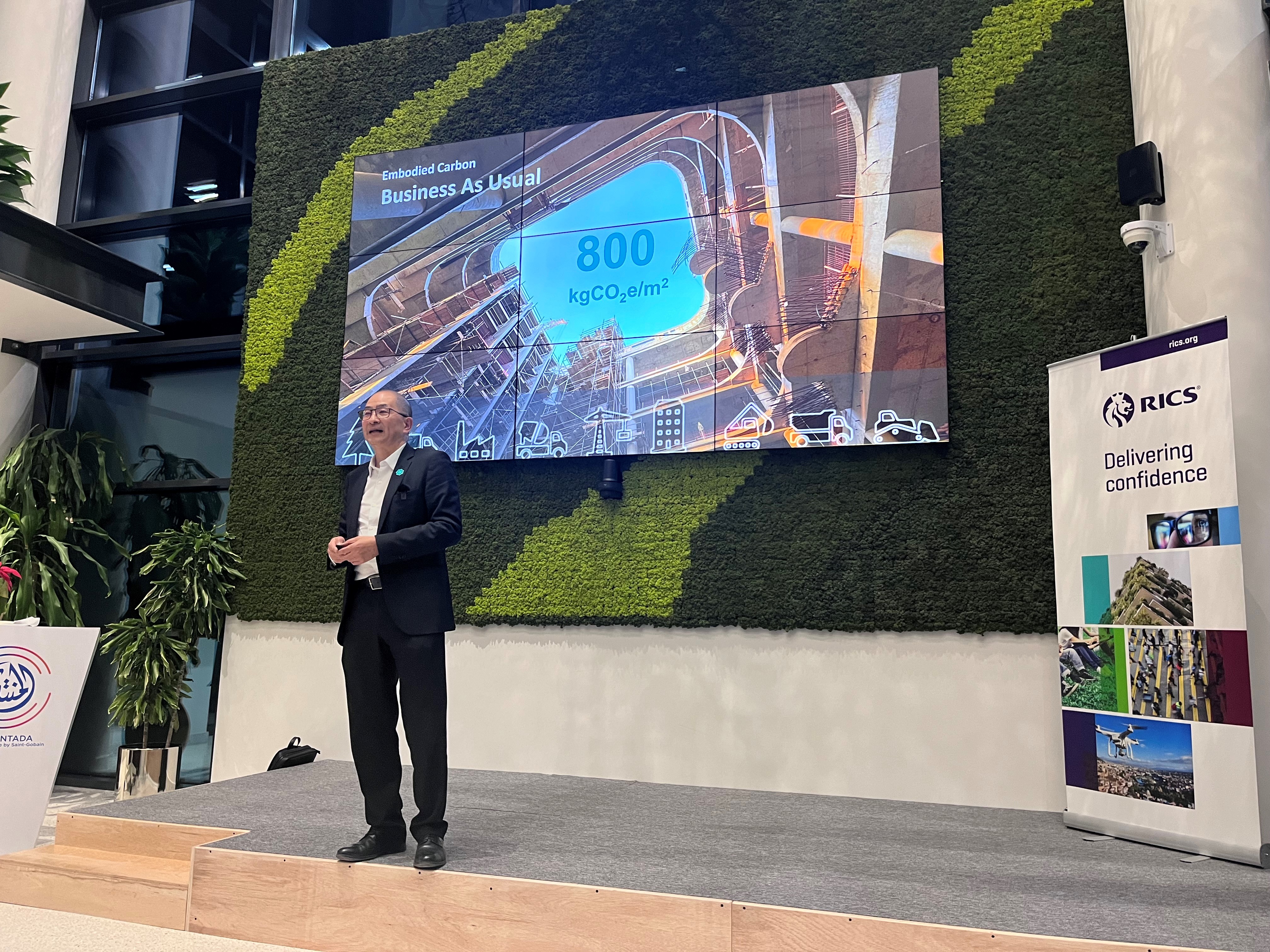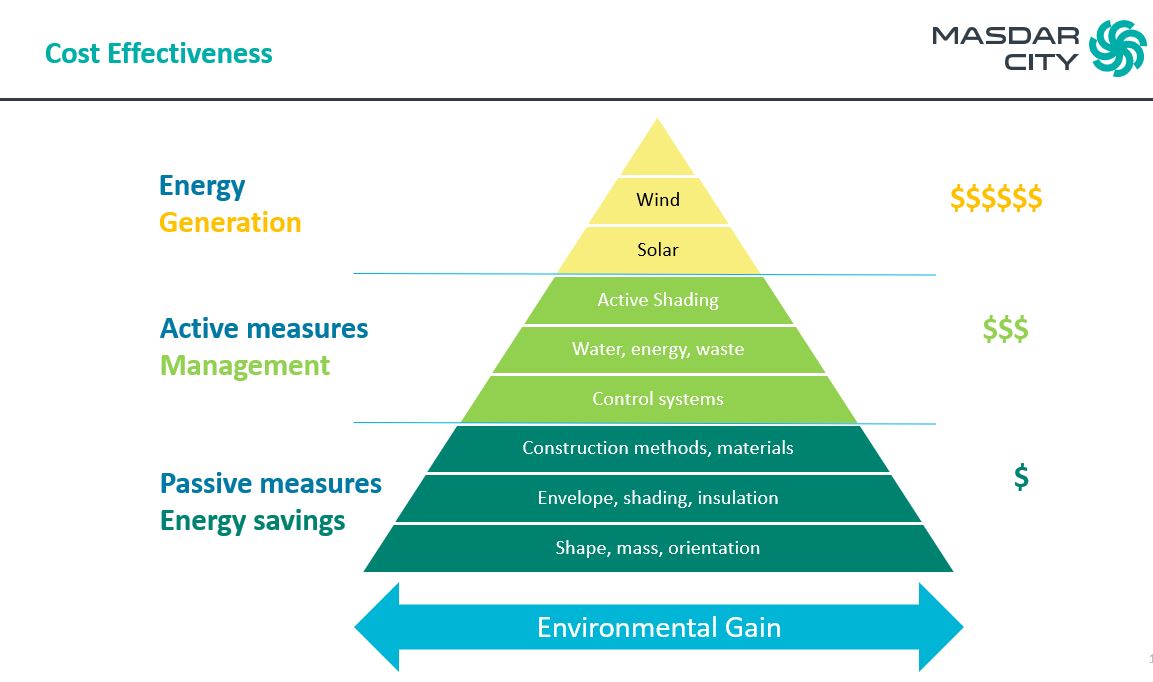Report: Chris Wan presents Masdar City's pathway to net-zero
1 Mar 2024
Share

Speaking to about 50 industry professionals, Wan began with an introduction to Masdar City, an Abu Dhabi sustainable urban community and innovation hub that has been on the path to net-zero for more than 15 years. Wan, a seasoned architect who specializes in sustainable building design, has been working at Masdar City almost since they broke ground in 2008—first in design management, and now as the organization’s sustainability lead—making him uniquely qualified to comment on Masdar City’s journey.

He began with a summary of carbon emissions statistics, noting that RICS offers an assessment tool for measuring carbon. Using its own measurement tools, Masdar City has been measuring its carbon footprint since its beginning, and it has always focused on reducing demand for both energy and water. It’s a strategy that has paid off.
Reducing energy and water demand
In 2022, Masdar City reduced energy demand by 38.4 percent, which is equivalent to taking 1,600 cars off the road. He also shared that they reduced water demand by 28.7 percent compared to the Estidama Pearl baseline—a water savings equivalent to emptying 27 Olympic-sized swimming pools.
Wan also spoke about Masdar City’s work in offsetting carbon—mainly in clean energy production. The organization returned an equivalent of 37 percent of its total energy use back into the Abu Dhabi electric grid thanks to energy produced using on-site photovoltaic (PV) solar panels.
Masdar City’s total energy emissions reduction in 2022 was an impressive 7,416 metric tons of CO2 equivalent. They’re on track to nearly double that number by 2025, and to achieve net-zero emissions overall by or before 2050.
The rest of Wan’s presentation sought to answer the next logical question: How?
Achieving net-zero by 2050
Short-term projections have a straightforward explanation: Masdar City is growing—and greening—exponentially. New net-zero energy buildings will reduce overall energy demand across the portfolio from 38.4 percent to 47.5 percent by 2025.
The city’s first net-zero energy commercial building, called NZ1, was complete in late 2023. A net-zero energy commercial headquarters, a net-zero energy shared working and living space, and a net-zero energy mosque will all be complete next year.
“Everyone wants to be in green buildings post-COP28 and post COVID-19,” Wan said. “We are at over 99 percent capacity. We’re not building fast enough. Our job is to keep up the momentum.”
How has Masdar City cracked the net-zero energy building code? Fifteen years of learning, collaboration, and continuous innovation.
“You have to innovate to go greener,” said Wan. “We used to think that 40 percent energy and water savings was the best we could do. We had no choice but to be commercially viable. It was a challenge and a blessing. We wouldn’t be here today if we hadn’t prioritized economics in addition to green design.”
Masdar City’s methodology
Wan shared Masdar City’s methodology, which includes setting tangible and measurable sustainability KPIs, building a collaborative, multi-disciplinary design team, and prioritizing an integrated design process.
“On some teams, you will have 20 people in the room, all of whom think their discipline is the most important. The challenge is integration,” said Wan. “How do they run in the same direction toward a single mission statement? We’ve been finding the answers for years. Masdar City is not about the buildings. It’s about solving this integration challenge. It’s about the people.”
Wan offered a building’s façade as one element of building design that can be designed collaboratively to maximize sustainability.
“The façade is the façade designer’s problem only if you care just about one thing: What it looks like,” said Wan. “What about waste, materials, windows, energy, and maintenance? Full-glazed windows look beautiful, but they will probably let in too much light and heat. If the windows are too small, they don’t make nice spaces or let in enough light. At Masdar City, we bring together all these inputs at once to find the magic medium.”
Wan then answered a vital question about cost: Sustainability doesn’t have to cost more—not if you make economical and green design priorities from the beginning. He showed that Masdar City has found a way to design buildings that achieve LEED Platinum ratings, the highest international standard for green buildings, at a cost comparable to conventional buildings.
Low cost, high return
The key? Focusing on the lowest-cost and highest-return techniques first: Passive design is an architectural approach that works with a building’s physical components and the natural environment to reduce energy and water demand. For example, angling and orienting windows away from direct sun, and optimizing the window-to-façade ratio to minimize heat transfer, both work to reduce the need for air conditioning—and they don’t increase the cost of development. Any cost savings can go back into making the building even greener using materials such as high-performance insulation and glass.
After maximizing passive design measures, Masdar City’s team moves on to active design, which includes things like active shading and technology-based control systems. Finally, they top up with clean energy generation. Wan shared a pyramid to help listeners visualize the approach.

Wan then took listeners through Masdar City’s gradual advancement to net-zero energy buildings using continuous innovation, beginning with the Incubator and Siemens headquarters buildings in 2012 and 2013, which achieved overall energy reductions of 45 percent and 32 percent, respectively. Numbers increased gradually in subsequent years. A dramatic decrease in the cost of solar panels made net-zero energy a more viable option in 2020, when conceptualization and design on Masdar City’s first net-zero energy commercial buildings began.
Moving beyond net-zero energy
Wan then moved on to next steps, explaining that net-zero energy isn’t enough: there is a gap between net-zero energy buildings and achieving net-zero carbon emissions overall. A net-zero energy building produces as much renewable energy as it uses. A net-zero carbon city offsets all of the carbon it produces, whether from energy, water, waste, or GHG production.
“We have to work harder on passive design,” said Wan, “and we need to add more PV. But the big elephant in the room is addressing embodied carbon.”
Embodied carbon refers to the GHGs emitted from the manufacturing, transportation, installation, maintenance, disposal of waste building materials and more. As important of an accomplishment a net-zero energy building is, Wan explained, it is, in many ways, just the beginning of decarbonization.
To address embodied carbon in the coming years, Masdar City plans to continue source low-carbon building and construction material for its projects. The organization will also focus on offsetting remaining carbon.
Wan explained that currently, standard buildings produce about 800 kilograms of CO2 equivalent per square meter. In 2022, Masdar City’s portfolio stood at 642 kilograms of CO2 equivalent per square meter overall.
NZ1, a small, simply designed net-zero energy commercial building, is expected to achieve 511kilograms of CO2 equivalent per square meter.
Assuming it is built to its
design specifications, Masdar City’s next net-zero energy building, the Masdar
City Square headquarters, will achieve 568 kilograms of CO2
equivalent per square meter.
By 2030, Masdar City needs to
innovate enough to achieve 400 kilograms of CO2 equivalent per square meter on its buildings.
Further carbon emissions offset can be achieved, explained Wan, using technological and nature-based solutions such as mangrove forests, which Masdar City is already beginning to plant.
Seeing sustainable design in action
Wan’s presentation was enhanced by a tour of Saint-Gobain’s AL-MUNTADA Knowledge Space, which showcased some of the design features and materials Wan spoke about. The Knowledge Space uses 25 different sustainable building materials, including a type of smart glass that adjusts to let in less light and heat at the sunniest times of day, which reduces the need for energy-efficient air conditioning.
For more information on Saint Gobain’s
innovation in sustainable building materials and design features of its AL
MUNTADA Knowledge Space, visit their website.
join our
community
Stay tuned and get to know the latest from Masdar City
Write a review Average rating:You've already submitted a review for this item